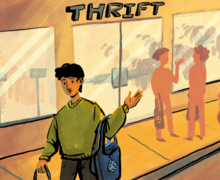Local groups work to mitigate food deserts as I-81 demolition looms
Arlo Stone | Digital Design Director
With the reconstruction of Interstate 81, Syracuse could see a change in the food desert landscape by developing a new community grid. Syracuse University organizations and city food banks have been working to combat this food insecurity.
Support The Daily Orange this holiday season! The money raised between now and the end of the year will go directly toward aiding our students. Donate today.
With the Community Grid Project still in its early stages, the landscape of Syracuse’s food deserts are facing a potential shift.
The project — which will create a new community grid with surface-level streets— officially began construction in July. Food deserts, or areas that have limited access to affordable food, have become more common largely due to the lack of grocery stores in areas of Syracuse. Some professors at Syracuse University and local organizers said the project may lead to increased development and accessibility, alleviating some of the city’s food insecurity.
Laura-Anne Minkoff-Zern, the graduate director of food studies at SU’s Falk College of Sport and Human Dynamics, said economic investment and removing the I-81 viaduct are required to reduce the prevalence of food deserts in Syracuse.
“It really comes down to economic inequality, that if you have people with money in hand, you’re going to have the ability to buy food and if you have people with money in hand, grocery stores are going to want to be in that area,” Minkoff-Zern said.
According to the United States Census Bureau, 30.1% of Syracuse residents live in poverty and, according to a 2017 report from the Onondaga County Health Department, 29% of households have no available vehicle. Specifically in the zip code 13202, located next to the I-81 viaduct, more than half of the residents are living in poverty and 50% of households do not have an available vehicle. There are no major supermarkets in the zip code.
As a result of a lack of access to grocery stores, neighborhoods like the one surrounding the I-81 viaduct have seen heightened levels of obesity, according to the same 2017 OCHD report.
SU’s Food Recovery Network, an on-campus student volunteer organization, has been working to combat food insecurity since around 2016. The group collects food scraps from dining halls on campus and distributes the food to people in need in the community, said Elliot Salas, president of FRN. Without taking proper action to reduce the amount of food deserts in the city, he said the demand for food will continue to grow.
“It’s not just as easy as just giving food and then packing up the food and just giving it to someone who needs it somewhere,” Salas said. “(It’s) making sure that it’s being spread equally among all these other food agencies across the city.”
The network donated almost 12,000 pounds of food across the city during the spring 2023 semester, breaking the previous record of 10,000 pounds in one semester. He said FRN distributes the food to some food pantries, shelters and churches in more “underdeveloped communities.”
Minkoff-Zern said the original construction of I-81, which split the historic 15th ward, has contributed to a lack of investment in food access. She said the scarcity of grocery stores is a result of the disinterest in investment in these areas.
SU’s Student Association also holds its own food drives to donate to local pantries, such as their Fall into Action event. SA’s Vice President Yasmin Nayrouz said SA has made significant donations to the Hendricks Chapel Food Pantry annually.
Murray Gould, food pantry director at St. Lucy’s Food Pantry, said his pantry works to not only feed the people of Syracuse but to give them the nutrition they need by working with dietitians. Over the past year, the number of people coming to his food pantry has been increasing, largely due to the rising cost of groceries, Gould said.
“People don’t want to come to a pantry, but they don’t have a choice … the increase in food prices is never-ending,” Gould said.
I-81’s demolition would have a positive impact on the issue of food insecurity, Gould said, because the opportunity for development would likely bring more grocery stores to areas that are currently food deserts.
Semika Bradshaw, a community health worker at the Dunbar Center Food Pantry in Syracuse, said the pantry is also working against food insecurity by offering healthy food options for those who may not have the transportation or the finances to shop at a full-service grocery store.
Unlike Gould, Bradshaw said she believes that I-81 coming down would negatively affect food insecurity in Syracuse by limiting access to the food bank’s location.
“If the I-81 project is done, it’s gonna cut the traffic that’s coming this way, that will come through here, along with it, making it harder for (residents) to get to this location,” Bradshaw said.
As the viaduct comes down, Gould said it’s important for food banks to interact with community members in a “highly sensitive” way that respects them.
“We always say this, that when (residents) come into the pantry, this may be the only positive experience they’ve had that day or that week,” Gould said. “Embrace them.”
Published on December 6, 2023 at 12:45 am
Contact Roxanne: rmboychu@syr.edu






